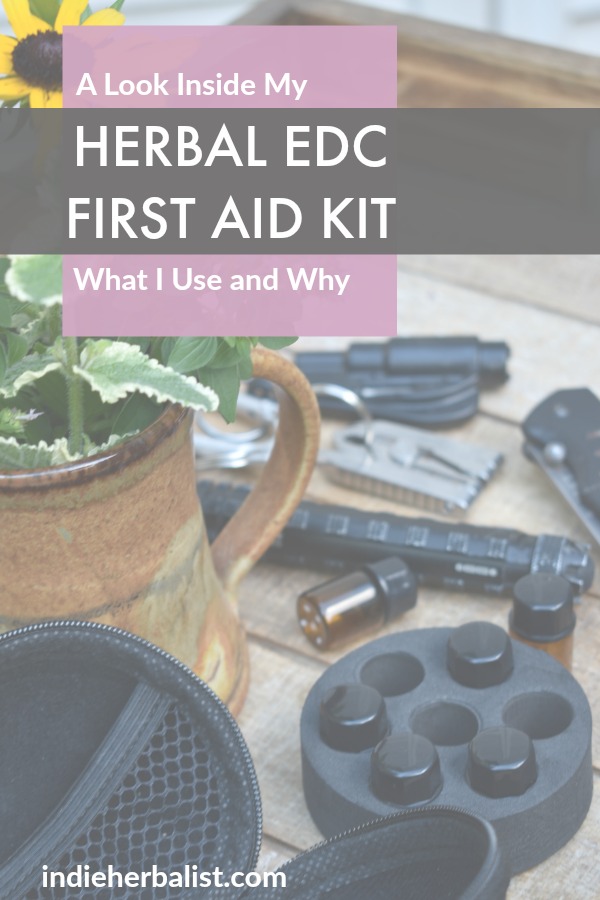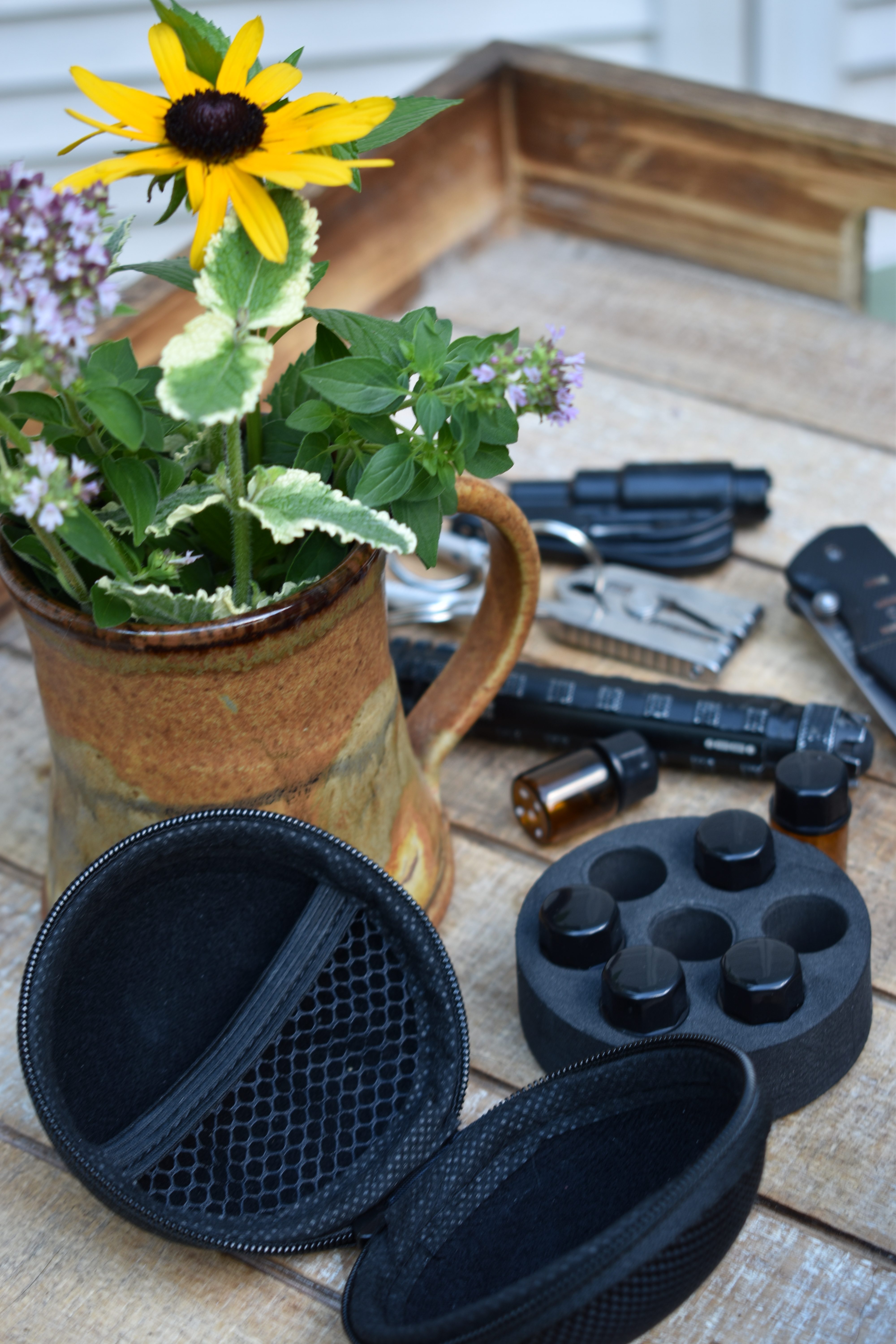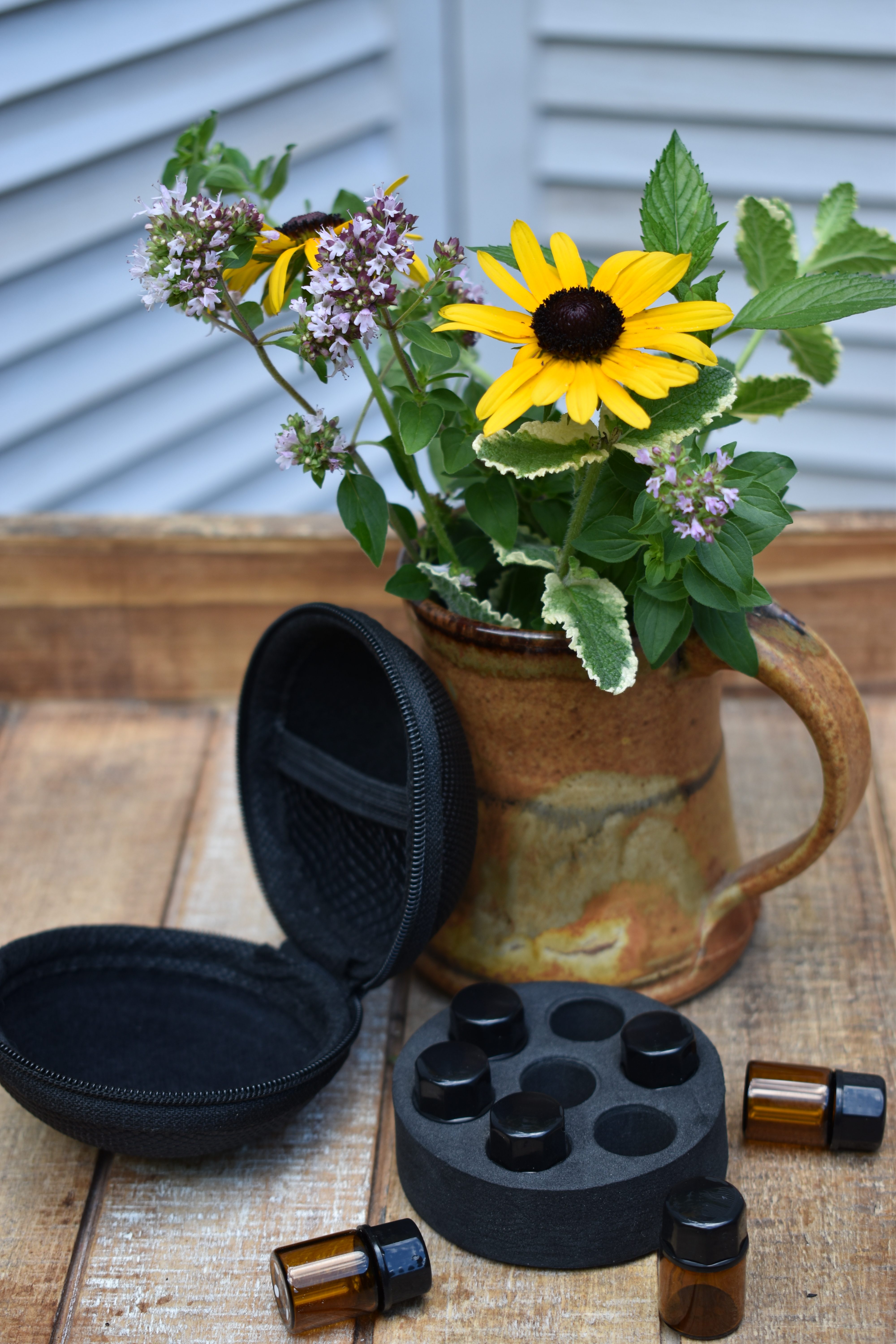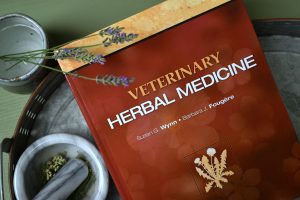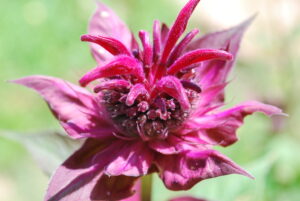Links contained in this post and elsewhere on my website may include affiliate links. When you make a purchase through these links, I earn a commission at no additional cost to you. I only link to products and services that I love - and that I think you will love, too!
Have you ever thought about building an herbal first aid kit, but weren’t sure where to begin? An everyday carry herbal first aid kit can be a great place to start!
My perspective on preparedness comes from living in rural areas combined with my love of hiking backcountry trails. I’m an herbalist, though, so it’s important to me to incorporate botanical strategies into my preps. Today, I want to share the first layer of my herbal preps: my everyday carry kit.
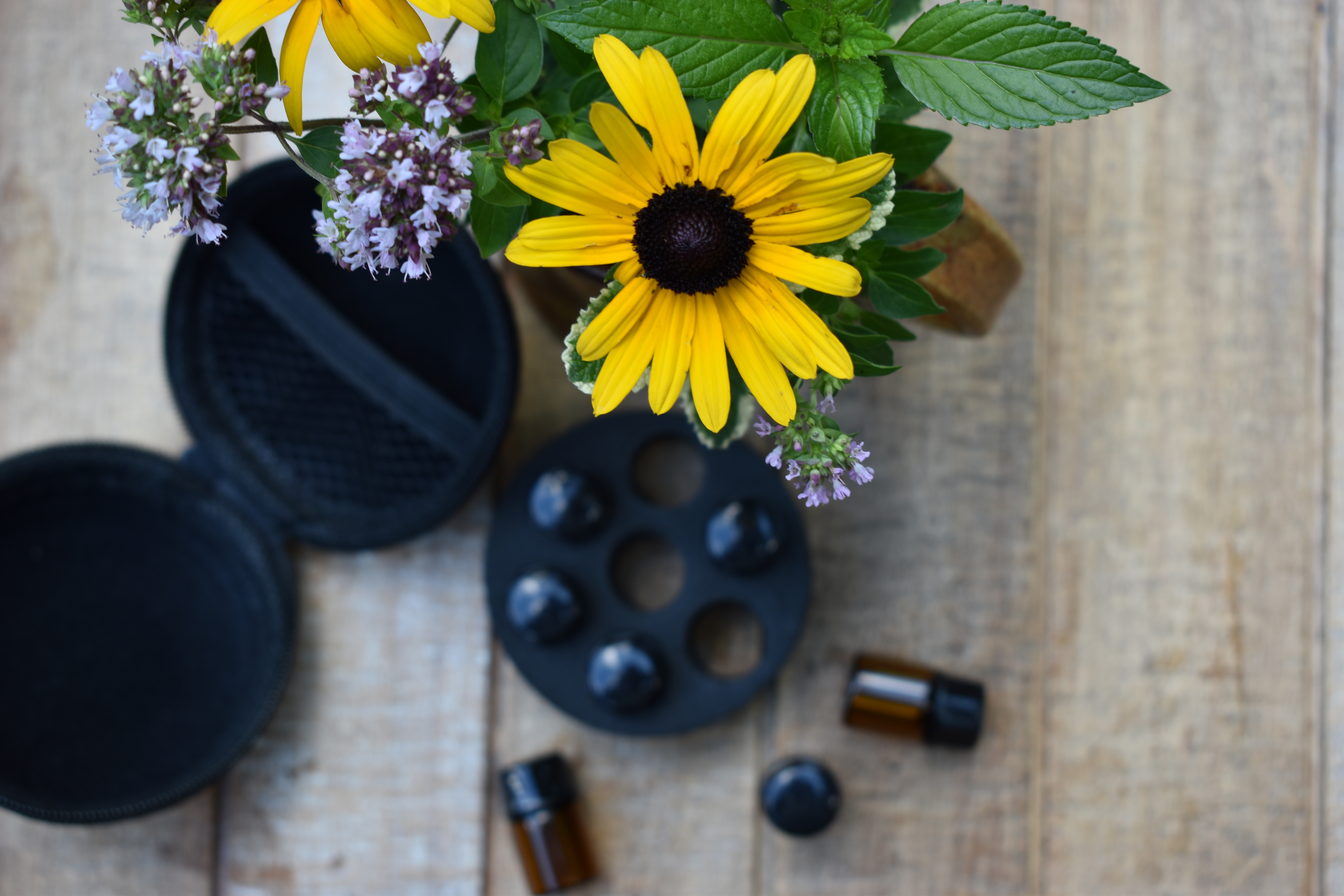
What is an Everyday Carry Herbal First Aid Kit?
Just like other types of emergency preparedness plans, it helps to think in layers with herbal preps. Everyday carry kits are small kits designed to be travel-friendly so they can address short term needs while you are on the go. For me, this means I carry 2 ml bottles in a case that easily fits in my purse, day pack, or pocket. The extracts I carry are tailored to fit my specific needs and are herbs and blends that I know work well for me.
My EDC Case
I use a small hardshell carrying case designed for essential oils. It comes with 7 empty vials with leak-proof caps. I love that I can toss it into my purse or hiking pack and don’t need to worry about it. A serving size for most herbal extracts is roughly .5-1ml, so each vial can hold 2 generous servings or be portioned out for 4 smaller servings.
I bought my case on Amazon, but it looks like the seller is out of stock. I did find a similar case and bottles that might work just as well, and it even has a little more room than mine.
The important features are the zipper closure, the hard shell case, and the foam insert. The zipper keeps everything firmly closed, and the case and foam help make it resilient to being dropped! If you can find bottles with stoppers for the reducer, that’s a plus. Usually, though, the reducer-style dispenser are not prone to leaking even without the leak tab.

Single Herbal Extracts in My EDC
Right now, I carry single herbs (simples) as well as herbal blends in my EDC. The simples I carry are: yarrow, albizzia, and tulsi. For single-herb extracts I don’t make at home, I typically use Herb Pharm extracts because they are really high quality and easy to order from Amazon. They even have albizia extract (#affiliate link), which is one of my favorites but used to be hard to find.
Yarrow
This is a multipurpose herb with lots of potential applications. My main rationale for including it in my EDC is emergency bleeding or injuries that might result in severe bruising. I find it’s also nice to have extra with me during my period, because it’s helpful for that kind of bleeding, too. As I’ve gotten older, my cycles tend to be heavier and more uncomfortable. Yarrow can make a big difference as far as restoring a more balanced flow. Oh- and it’s also nice to have in a pinch for nosebleeds!
Albizia
Albizia flowers and bark are used in Traditional Chinese Medicine to support wound healing and clear bruises, and to support mood. I include albizia in my EDC for emergencies that involve an emotional component. In “The Modern Herbal Dispensatory,” Easley and Horne describe Albizia as a euphoric. In my experience, this is one of the herbs most likely to provide a strong, rapid lift in mood for me and is very specific for emotional states related to grief. A sudden death, car accident, or active shooter incidents are all potential reasons I would reach for Albizia. Obviously, it won’t magically make everything better, but it does help take the edge off so you can take a few deep breaths and think more clearly.
You can purchase Albizia extract from Herb Pharm on Amazon (#affiliate link).
Tulsi
Some days are just harder than others. When I worked retail, I was always really glad to have tulsi on hand in my EDC for super stressful days at work involving high maintenance customers or touchy co-workers. Tulsi is also very focusing for me, and helps me settle in and find “the zone” even when everyone else is generating chaos. Naturally, it’s a great ally during emergency situations. Like albizia, I typically respond to tulsi quickly – within fifteen minutes or so.
Herb Pharm makes a very high quality tulsi extract (#affiliate link).
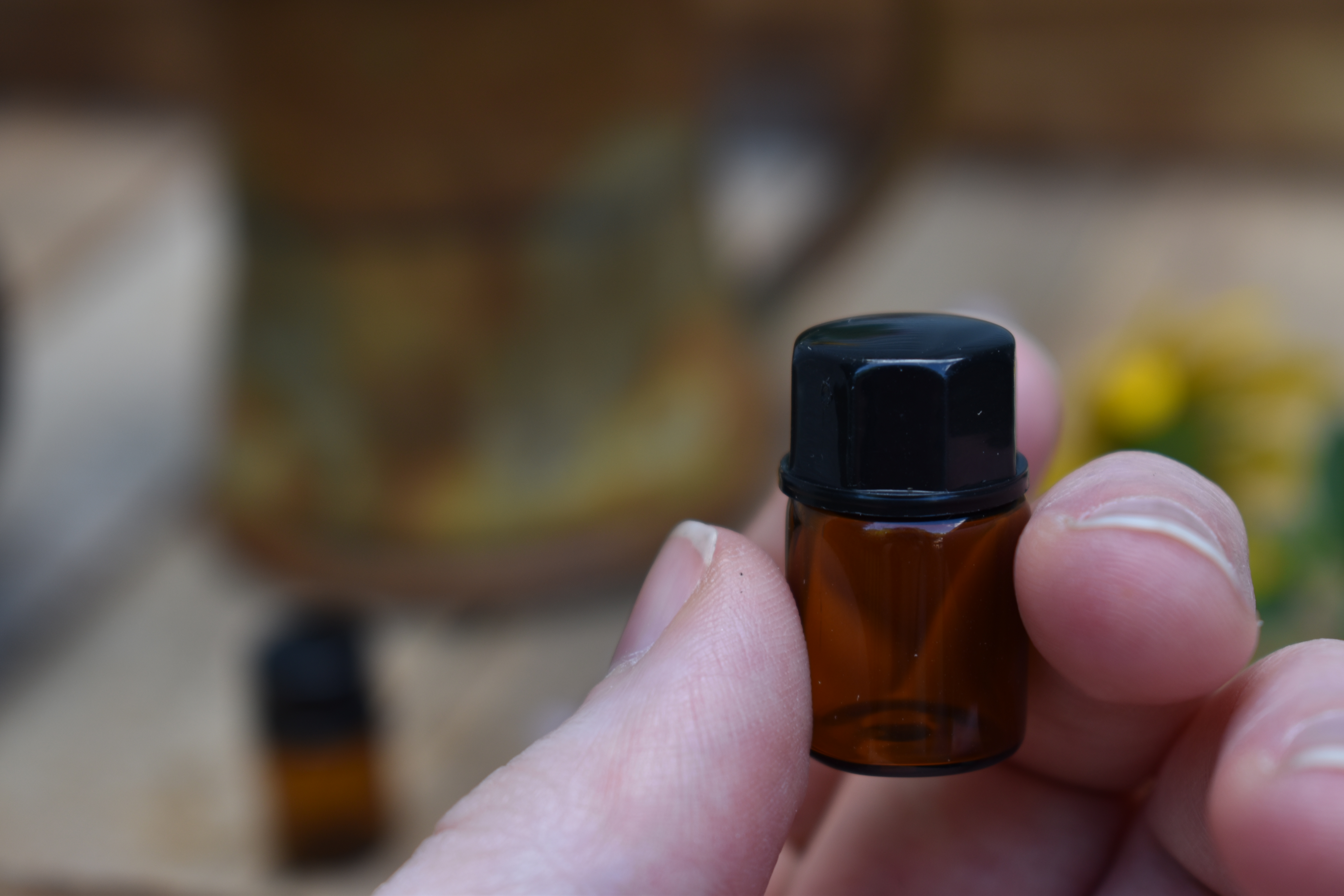
Herbal Blends in my EDC Kit
My herbal blends are a pain support formula, an adaptogen blend, a digestive blend, and an acute respiratory support blend. These are custom blends based on what I know I like and what works well for me. You can also use blends by companies like Herbs Etc, Herb Pharm, or Gaia Herbs.
Nervous System Blend for Pain Support
My blend includes prickly ash, Jamaican dogwood, black cohosh, and cramp bark. When I worked retail, this was heaven for my back on long days on my feet on concrete floors. Prickly ash is typically associated with nerve related pain and is a nervous system tonic, while Jamaican dogwood is used as more of a general pain relief herb in traditional herbalism. Black cohosh and cramp bark are both very good for relaxing tense muscles or when there is pain caused by cramping or spasm. In the Earthwise Herbal, herbalist Matthew Wood notes that black cohosh is a specific for whiplash. So, nice to have for work related pain, in case of a car accident, or yeah. . . when my uterus is being angry.
Digestive Blend
Digestive bitters help support digestive comfort after meals. I have a ginger and orange peel digestive bitter that I really love, and when I mix it up for my EDC I add a splash of meadowsweet. Meadowsweet is used in traditional herbalism for balancing the acidity of the digestive tract. Ginger is a multipurpose ingredient, as it is traditionally used for carminative qualities and to settle the stomach.
Acute Respiratory Support Blend
My blend includes elecampane, pleurisy root, and lobelia. My lungs are one of my weak points, and having a blend to use in the event of dusty, moldy, or extra stressful environments is a plus. Elecampane is a general tonic for the lungs, and pleurisy root has an affinity for inflamed states of the respiratory tract. Lobelia is a low-dose botanical but I’ve found that I tolerate it well as an herb to release excessive tension from the lungs.
Adaptogen Blend
Of course, I love adaptogens- so two of my vials are dedicated to a blend of rhodiola, eleuthero, and schisandra. These are the three (besides tulsi) that I resonate especially well with. Rhodiola and eleuthero are both supportive of immunity in several ways and are excellent for stamina and endurance. Like tulsi, I find schisandra to be very balancing for cognitive function, so I like to include it for a little extra mental sharpness. In an EDC capacity, my adaptogen blend is my go-to when my long day just got longer. It’s also nice to have it on back country hikes for a little extra boost.

Other Components of my EDC
Inside the case of my herbal EDC kit, there’s room for a slip of paper with info about what’s in each vial. There’s not much room on the vials themselves because they are tiny! Rather than put labels on them, I used nail polish to mark the bottom of each one. There’s also room for a few adhesive bandages, alcohol swabs, and single use packets of antibiotic ointment.
In addition to my herbal supplies, I carry a small Bushnell flashlight, a CRKT knife, and a small multi-tool as part of my EDC. These items fit in the outside pocket of my hiking pack, and are also compact enough to fit into my purse. I usually carry a small purse, so having a streamlined EDC is important to me.

Personalizing Your Everyday Carry Herb Kit
It’s easy to customize an everyday carry herbal kit to fit your own needs. The ideas I’ve included here are what works well for me, but you may find that other herbs are more appropriate for you. If you take prescription medications, please check with your doctor or pharmacist before using herbs. Even though it’s not common, there is always the potential for herbs to interact with prescription medications.
It’s important to have a good working knowledge of whatever you choose to carry in your herbal EDC. That means carrying herbs you have used at least once. Preferably, you should use them several times and know are reliable for you.
It’s also a great idea to study and research any new herb you add to your wellness routines. Some herbs are quite versatile, and taking the time to get to know each one in-depth pays off in spades. If you enjoy online classes, the Herbal Academy has a Materia Medica course (#affiliate link – I helped write it so I know it’s great!) that teaches how to really focus in on one herb at a time to build your knowledge. Their other courses are worth a look, too (#affiliate link).
Read More About Herbal First Aid Kits
I recently taught a class for Lisa Bedford’s Survival Mom Sisterhood about my top five herbs for emergency preparedness. We also talked about the way I plan my herbal first aid kits using layers. It was a really timely topic, because I’ve been working on a series of blog posts here on Indie Herbalist about exactly what I use and why.
Lisa runs a great website called Survival Mom, and her handbook on emergency preparedness (#affiliate link) has been one of my favorites to recommend to new preppers for years now. I’ve contributed articles to Lisa’s blog and it’s always a pleasure to work with her. In fact, one of my articles on Survival Mom discusses types of herbal first aid kits – so be sure to head over and give it a read!
